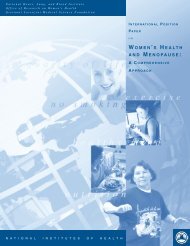HeartsNParks Community Mobilization Guide - National Heart, Lung ...
HeartsNParks Community Mobilization Guide - National Heart, Lung ...
HeartsNParks Community Mobilization Guide - National Heart, Lung ...
Create successful ePaper yourself
Turn your PDF publications into a flip-book with our unique Google optimized e-Paper software.
Take the time to be physically active as<br />
a family. This not only provides health<br />
benefits for the entire family but can be<br />
an important time to get to know each<br />
other better. Young kids particularly<br />
enjoy being involved in family fun,<br />
such as shooting hoops with dad or<br />
playing tennis with mom.<br />
Adults who have not been active for a<br />
while should start slowly, gradually building up to<br />
the recommended 30 minutes per day of moderatelevel<br />
activity. For example, if you want to begin<br />
walking regularly, you might begin with a 10–15minute<br />
walk three times a week. As you become<br />
more fit, you can increase the sessions to every<br />
day and gradually lengthen each walking session<br />
or increase your pace. Some adults should get<br />
medical advice before starting a program of<br />
physical activity. Consult your doctor first if you:<br />
• Have heart trouble or have had a heart attack;<br />
• Are taking medicine for high blood pressure or<br />
a heart condition;<br />
Keys to Success<br />
• Are over 50 years old and not used<br />
to moderately energetic activity;<br />
•Have someone in your family who<br />
developed heart disease at an<br />
early age.<br />
Seniors also need regular physical<br />
activity. Regular physical activity is<br />
good for your heart, mood, muscles,<br />
and arteries, and improves your bones<br />
and ability to sleep well. It builds strength,<br />
promotes coordination and balance, and helps slow<br />
bone loss and prevent fractures from osteoporosis.<br />
Many older people think they are too old or too<br />
frail to exercise. Nothing could be further from<br />
the truth. Physical activity of any kind—from<br />
heavy-duty exercise, such as jogging or bicycling,<br />
to easier efforts like walking—is good for you.<br />
Older people who become more active—including<br />
those with medical problems—may feel better<br />
and have more energy. Being active is also an<br />
easy way to share some time with friends or family,<br />
as well as to meet new friends.<br />
• Go slow. If you have not been physically active until now, gradually build up to the<br />
recommended 30 minutes per day of moderate-level activity.<br />
• Begin each workout slowly. Allow a 5-minute period of stretching and slow movement to<br />
“warm up” and 5 minutes at the end to “cool down” at a slower pace.<br />
• Listen to your body. A certain amount of stiffness is normal at first. But if you hurt a joint or<br />
pull a muscle or tendon, stop the activity for several days to avoid more serious injury.<br />
• Pay attention to warning signals. Some types of physical activity may worsen heart problems.<br />
Warning signals include sudden dizziness, cold sweat, paleness, fainting, or pain or pressure in<br />
your upper body or chest during—or just after—physical activity. If you notice any of these<br />
signs, stop and call your doctor immediately.<br />
• Check the weather. Dress appropriately for hot, humid days and for cold days, and drink lots of<br />
water before, during, and after activity.<br />
• Keep at it. Unless you have to stop your activity for a health reason, stay with it. Set small,<br />
short-term goals for yourself. If you find yourself becoming bored, try doing the activity with<br />
a friend or family member. Or switch to another activity.<br />
F-8
















